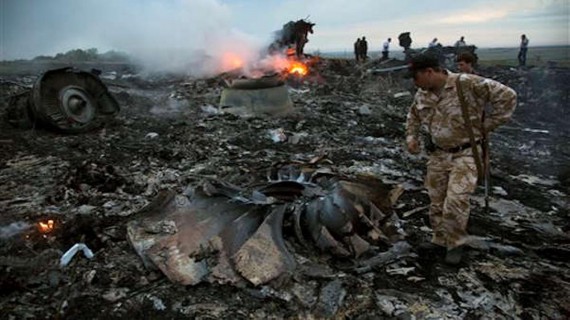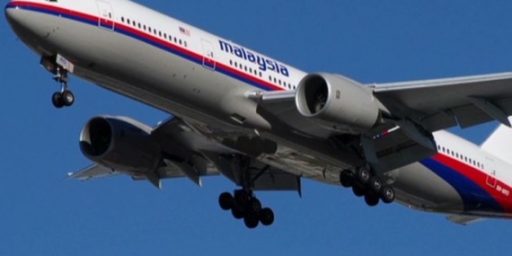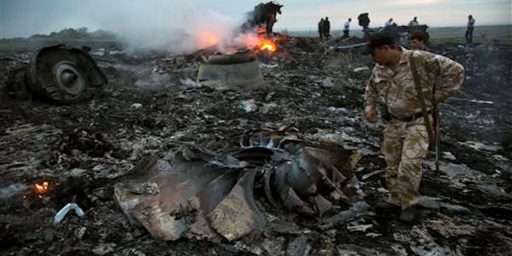Malaysian Air Flight 17 Inquiry Finds Plane Most Likely Taken Down By Russian Missile
A Dutch inquiry has largely confirmed what was widely believed about the fate of Malaysian Airlines Flight 17.
In an investigation that lasted more than a year, an investigation into the crash of Malaysian Airlines Flight 17 in July of last year concluded what pretty much everyone had assumed from the beginning, that the plane was most likely shot out of the sky by a Russian-made missile:
PARIS — A 15-month inquiry into the disintegration of Malaysia Airlines Flight 17 in the skies over eastern Ukraine has concluded that the aircraft was most likely struck by a Russian-made missile, Dutch air accident investigators said on Tuesday.
The findings — based in part on a distinctive shrapnel pattern that was found in the cockpit, near where the missile hit — are the most detailed so far from a five-nation investigative team that retrieved and sifted through several tons of debris and human remains.
“Flight MH17 crashed as a result of the detonation of a warhead outside the airplane above the left-hand side of the cockpit,” said Tjibbe Joustra, chairman of the Dutch Safety Board, using a common reference to the flight number. The explosion tore off the forward part of the plane, which broke up in the air. The crash killed all 298 people aboard; the investigation found that many died instantly, while others quickly lost consciousness. “It is likely that the occupants were barely able to comprehend their situation,” the board found.
While the findings stop short of assigning responsibility for the crash, a task that has been left to Dutch prosecutors, they appear consistent with a theory widely promoted by the authorities in the United States and Ukraine: that the plane, a Boeing 777, was shot down by Russian-backed separatists armed with an SA-11, or Buk, surface-to-air missile launcher.
Russia has vehemently disputed that theory, and it continued to do so on Tuesday with a competing presentation, saying that the missile must have been fired from Ukrainian-held territory, and that it was of a type that is no longer found in Russia’s arsenal.
The report on the July 17, 2014, crash was presented at the Gilze-Rijen Air Base in the Netherlands. The flight’s 283 passengers and 15 crew members came from about a dozen countries; 193 of the passengers were Dutch.
The board was sharply critical of the Ukrainian authorities for failing to close the airspace above the conflict zone. It found that 160 civil aviation flights went through on the day of the crash, until the airspace was closed.
“Why was Malaysia Airlines Flight MH17 flying over an area where an armed conflict was taking place?” Mr. Joustra asked. “The question was on the minds of many people after the crash. The answer was as straightforward as it is disquieting: almost all operators were flying over that area. And why? Because nobody thought that civil aviation was at risk.”
There was sufficient reason to close the airspace as a precaution, but “the Ukrainian authorities failed to do so,” he said.
The report is unlikely to produce consensus. Based on the impact pattern, the impact angle and other data, the Dutch board concluded that the missile originated in an area of about 320 square kilometers (about 123 square miles) in eastern Ukraine. But Russian experts say the area must be smaller, and Ukrainian experts say it was smaller still.
The team of investigators was led by the Netherlands but included members from four other countries heavily affected by the crash: Australia, Belgium, Malaysia and Ukraine.
To a large degree, the investigation only seems to have confirmed what was widely believed in the wake of the July 2014 crash, which came at a time when the war between the Ukrainian Government and the Russian-backed rebels in the east was at its peak. On the same day as the crash, there were already reports that U.S. intelligence sources had concluded that the plane had been taken down by a surface-to-air missile, a conclusion that was buttressed some two weeks later when it was reported that the initial investigation had shown evidence consistent with a missile strike. Since Ukrainians did not have any surface to air missiles in the area where the plane went down, the obvious conclusion was that the plane had been downed by a Russian missile fired either by the rebels or by Russians themselves. The fact that it coincided with several incidents in which rebels had used missiles to take down Ukranian aircraft in the same general area was seen as further corroborating evidence for the theory that it was a Russian missile that took down a commercial airliner. The Russians, of course, denied this vehemently and denied that they had given the rebels any access at all to surface-to-air missile technology of any kind, and the version of events that the Russian people saw regarding the downing of MH17 was quite different from what was being reported elsewhere in the world. It’s not surprising, then, that the Russians are already pushing back on this report quite heavily:
From the outset, the Russian government has tried to offer alternative versions of what caused the plane to break up over eastern Ukraine.
Initially, the Defense Ministry presented what generals said was radar data indicating that a Ukrainian fighter jet had flown nearby, possibly shooting down the Malaysia Airlines flight. This year, officials with Almaz-Antey, the state corporation that manufactures the Buk antiaircraft missiles, held a news conference in Moscow to say that they believed one of their missiles had shot down the plane, but that an analysis of the angle of impact showed it must have been fired from territory controlled by the Ukrainian Army.
Then, this month, after a Ukrainian security official had suggested in an interview with the Dutch news media that shrapnel removed from the bodies of the victims proved a Buk was to blame, Tass, the Russian state news agency, quoted an independent expert objecting that it was too early to conclude such a missile brought down the plane.
Tass quoted the expert, Ivan P. Konovalov, the director of a Moscow research center, the Center for Strategic Trends, as saying that if the Dutch Safety Board indeed “reaches a firm conclusion that the Boeing was struck by a Buk antiaircraft rocket, then it should be taken into consideration that at that time only the armed services of Ukraine had these complexes and the People’s Republics of Donbas had no such complex systems then or now.” He was referring to pro-Russian separatist governments set up in the Donbas region in eastern Ukraine.
In Moscow, officials at Almaz-Antey staged a dueling presentation on Tuesday with a dazzling element: the company blew up a civilian airline fuselage with one of its missiles, and showed the blast on video.
The experiment that shredded the cockpit section of a decommissioned Il-86 airliner, company officials said, indicated the Ukrainian military fired the missile that brought down the Boeing, without elaborating on why.
In the sky over Ukraine, the Russian officials said, the shrapnel struck the plane from an angle indicating the missile was launched from Ukrainian-held territory. Also, they said, Buk missiles in the Russian arsenal explode in a cloud of shrapnel that has jagged edges, described as having a “double-T” form. These, they said, leave a characteristic “butterfly”-shaped hole in airplane fuselages. The Russians insisted that no such holes were found in the wreckage; the Dutch report suggests otherwise.
In any case, Yan V. Novikov, the director of Almaz-Antey, said the Ukrainian government bore responsibility for allowing the flight over a war zone.
“I cannot say they are guilty, or not guilty, but the obligations of the country where a military conflict is underway is to inform aviation companies, or close its airspace,” he said.
While unlikely to convince many people, the presentation continued the Russian approach of floating multiple alternative theories, casting doubt on the official investigation. The Kremlin has denied any involvement in arming separatist fighters in eastern Ukraine or the shooting down of the Malaysia Airlines flight.
As noted, this inquiry did not attempt to assign responsibility for the downing of Flight 17, only to determine its most likely cause. The task of assigning responsibility is left to prosecutors in The Netherlands, but its hard to see how they’ll be able to come to a definitive conclusion. By all accounts, neither the Russians nor the rebels have been at all cooperative in the investigation, so the only evidence available is that which has been recovered from the crash site as well as any other information that may be obtained from assets such as satellite imagery or communication intercepts. Absent a smoking gun, or in this case I suppose you’d call it a smoking missile, it seems unlikely that we’ll ever know much about the course of events that led to the missile being launched in the first place unless someone decides to talk, and that seems unlikely for the time being. Off the top, it seems unlikely that the downing of the plane was a deliberate act, though. The public relations disaster for both the Russians and the rebels of downing a civilian airliner are bad enough without it becoming known that the plane was deliberately targeted. The most likely explanation seems to be that whomever was operating the missile battery believed that they were firing on a Ukrainian military aircraft of some kind and that they didn’t realize what had happened until much later. That doesn’t completely absolve them of moral or legal culpability, of course, but given the context of the conflict in eastern Ukraine at the time, the accidental shoot down theory does seem to be the most plausible.
At the time that Flight 17 crashed, there was much concern that the event would mark a new turn for the worse in a conflict that had been escalating since the spring of 2014. As it turned out, that didn’t occur, and while the conflict in the east continues on some lower level between Ukraine and the pro-Russian levels we have not seen the escalation that many feared could occur. With Russia now seemingly concentrating its resources in Syria, it seems unlikely that we’ll see any such escalation in the wake of this report. Nonetheless, the report itself serves as a reminder that the war in Ukraine continues and that Russia has yet to be fully honest about its involvement and the extent to which it has aided a group of rebels that seemingly sprung up out of nowhere in the spring of 2014.
Here’s the report:





If only we had a strong leader like that Republican hero, Vladimir Putin.
Wow, just wow.
To American ‘interventionists’ I again ask: Explain to me how America can use it’s military power to prevent rogue separatists from doing these kinds of things?
Well, we ended up shooting down an Iranian skyliner by mistake, so I’m not sure we should be patting ourselves on the back too much.
Here’s a comparison of the two cases, although the author tries too hard (IMHO) to distinguish the two and end up with “US white hats, Russia black hats”. The fact is, we killed a hell of a lot of people who were flying in a war zone by mistake by a missile which was under control of our own military. Russia casually handed over one of its missiles to a quasi-agent group that ended up killing a hell of a lot of people through carelessness or deliberate targeting of a known civilian flight. Which level of stupidity is greater?
@grumpy realist: There was fairly detailed investigative journalism for the USS Vincennes incident. IIRC it was during hostilities, but commercial flights were routinely operating over the Gulf. The Iranian flight was scheduled, following a commercial route, and more or less on schedule. It’s transponder was operating, putting out a civil aviation signal. The climbing airliner was mistaken for a descending fighter/bomber and targeted. There was a story that an Iranian air force plane on the ground near Tehran had powered up a military transponder at roughly the same bearing from the Vincennes as the airliner. The Captain was reportedly a cowboy who had exceeded his orders and pushed into Iranian territorial waters. I believe he was never reprimanded in any way.
No particular moral to this story except that if someone starts a war, spit happens. More likely to happen if you push your Captains to be over-aggressive. And as far as I recall the airliner was where it was supposed to be, doing nothing wrong.
Old news, but it’s worth remembering back to brief period where some of the separatists were expressing both some degree of guilt and admitting culpability in the attack:
AP Journalists Saw Rebels With BUK Missiles Hours Before MH17 Crashed:
Corriere della Sera interview w/ a rebel squad leader
(transl. by the UK Independent)
@grumpy realist:
A better example is the Ukrainian shoot-down of an airliner on Oct 4 2001. They were shooting at a target drone and the same model missile managed to lock on to a passing airliner and knocked it down.
There are good reports the Ukes had put up some Frogfeet just a bit before. If I had been a Rebel I’d of had a couple guys watching the airport for that and phone “a couple Froggies on the way” to the boys in the launcher. Zeal over possibly nailing one of those could make the crew a wee bit tunnel-visiony and eager, mis-IDing or even not noticing something much higher and further away beyond the intended target.
And now we have the “it’s all the fault of lithium batteries!” story.
I wonder how much the Russians are paying this reporter? (I don’t usually indulge in conspiracy thinking, but–exploding batteries? Vs the result of a missile? Pull the other one, guys, it’s got bells on.)